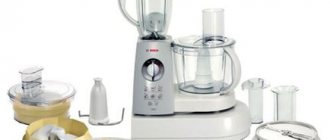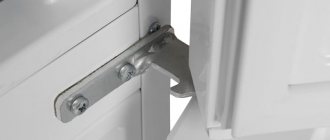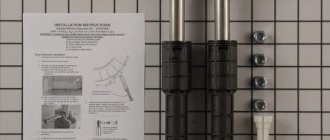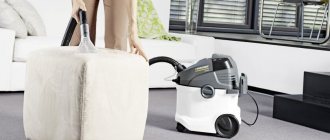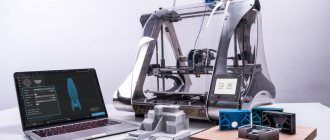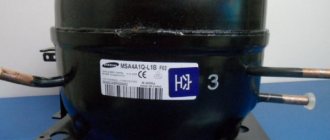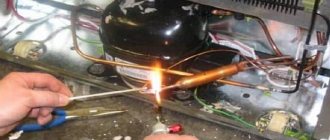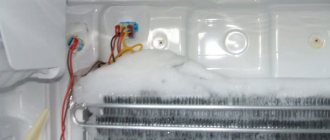Classification by principle of action
To an inexperienced user, it may seem that all refrigeration units are designed approximately the same. However, this is not the case. Based on the principle of operation, there are three types of household refrigerators.
Before you start repairing your equipment, you need to know exactly how the refrigerator works. Therefore, we will consider each of these types in detail.
Operating principle of compression refrigerators
To cool the chambers of the unit, in this case, a special liquid is used, which is capable, under certain conditions, of transitioning from liquid to gaseous form and back at room temperature.
This is the so-called refrigerant. It is pumped into a closed circuit, moving along which it performs the cooling process. This happens as follows. First, the refrigerant in liquid form is injected under pressure into the evaporator.
A refrigerator is a complex unit. Unfortunately, it is not always possible to repair it yourself. If you have problems with repair work, it is better to call a specialist
It is shaped like a coil so that the cooling process is as efficient as possible. The nozzle through which the refrigerant is supplied is called a die.
In household equipment it is a small fragment of a non-profiled capillary tube. In industrial models where high productivity is required, profiled dies are used.
Once the refrigerant enters the evaporator, it begins to rapidly expand, turning into gas. It takes a certain amount of heat from the air, which corresponds to its heat of vaporization. This lowers the temperature in a well-insulated refrigerator or freezer and keeps everything inside cool.
Most often in the kitchen there is a compression-type refrigeration unit. The principle of its operation is very simple. The diagram below will help you understand it.
The normal evaporation process will only continue until the pressure inside the evaporator increases. For this reason, the compressor continuously pumps out refrigerant vapor and supplies it to the radiator.
This is another coil inside which the refrigerant gas turns into a liquid. At the same time, it releases heat into the air. Next, the liquid is fed into the die and the cycle is repeated. What are the advantages of such a design? First of all, it is an efficiency approaching 100%.
In addition, compression equipment is economical, efficient and easy to adjust. Absolutely safe and chemically neutral compounds are used as refrigerant in such units. The main disadvantage is the presence of detachable connections, moving and rubbing parts.
In addition, the refrigeration circuit has mechanical connections with the external environment, which requires high-quality seals. There is one more significant unpleasant moment.
Compression units cannot remain charged and inoperative for a long time. Due to the design features of the circuit, the likelihood of microcracks sharply increasing, through which refrigerant subsequently leaks
Nuances of the operation of absorption units
The design of absorption-type units has some similarities with compression devices. However, its main difference is the absence of rubbing or moving parts.
Let's consider the principle of operation of such devices. The refrigerant is a low-boiling compound that dissolves well in a high-boiling liquid. The latter is called an absorber.
The main advantage of absorption units is durability and reliability. they are devoid of rubbing parts, all liquids flow inside the structure by gravity (+)
The same name is given to a container that contains a certain amount of concentrated refrigerant. From here it enters a thermal pump, which is a copper tube installed vertically, which is heated by an electric coil.
Next, the refrigerant moves to the steam generator, which is heated by electric current. Here the refrigerant evaporates and mixes with the absorber vapors.
The resulting mixture moves into the reflux condenser. This is a specially designed radiator in which the absorber and coolant are separated. The first condenses and goes into the steam generator, and the gaseous refrigerant is sent first to the condenser, then by gravity to the evaporator.
Here a cooling process occurs, similar to that which occurs in compression units. After which the refrigerant that has absorbed the heat is absorbed by the absorber and the process is repeated.
Absorption-type refrigerators are durable and can remain charged for years without working. Thanks to this, they are readily purchased for summer cottages and other houses with seasonal residence.
Thus, the main advantage of absorption models is their practically unlimited service life due to the absence of moving elements. However, they are not economical enough, because... consume approximately 1.5 times more energy than compression ones.
In addition, such refrigerators freeze rather poorly and slowly. Another significant disadvantage is security.
Water is used as an absorber, and ammonia is used as a refrigerant. As a result, the circuit contains highly concentrated ammonia. If there is a possible leak, this is dangerous. Models are available that run on isobutane or propane, but this is even more dangerous.
Considering that absorption units can be stored turned off and charged indefinitely, they are readily purchased for use in homes with seasonal residence.
A significant disadvantage of absorption refrigerators is their wasteful energy consumption: models for cars can discharge the battery in a few hours. Therefore, some mobile models use a system for switching to gas, which is usually switched to when parked (+)
Cold from semiconductor technology
These are rarely used devices whose operating principle is based on the Peltier effect.
It lies in the fact that a junction of dissimilar conductors, when an electric current is passed through it, heats up in one direction and freezes in the other, compensating for the heating of the other side. This way you can get temperatures down to -40ºС and even lower.
The operation of a semiconductor refrigerator is based on the Peltier effect. The figure schematically shows the operation of a semiconductor battery
However, the system has significant drawbacks. First of all, this is high energy consumption. It is much higher than that of low-cost absorption devices. In addition, Peltier elements have a limited resource.
At the same time, semiconductor refrigerators are insensitive to mechanical stress and freeze food quickly and efficiently. If necessary, it is possible to switch the direction of the current, which allows you to quickly defrost the system.
The advantages of thermoelectric refrigerators include insensitivity to shocks and the absence of a coil with refrigerant, which can leak due to microcracks in the tubes. They quickly defrost and also reach operating temperature.
Self-repair: what is possible and what is not?
In order to repair your refrigerator, and not completely break it, you need to know exactly which parts of the system you can fix yourself, and which parts are better left alone. In any refrigeration unit, four circuits can be distinguished:
Refrigeration system. This includes the cooling circuit itself, including the coils. This is the least suitable part of the unit for self-repair.
Craftsmen strongly do not recommend trying to carry out independent repair work in the absence of knowledge and experience in this area. Doing it yourself can be very expensive. Unskilled repairs most often result in the need to purchase a new unit.
Thermoregulation system. This is where breakdowns most often occur. Repairs are most often possible, but experience in carrying out such work is desirable.
You need to understand that self-repair will require the availability of spare parts, which are not always readily available. Most likely, you will have to order them from a specialized online store and wait for some time for delivery. For this reason, it may be better to call a refrigeration repair specialist.
Electronically controlled refrigerator thermostats are connected to a circuit board and repairing them requires the skills and knowledge of an electronics engineer. But you can change the mechanical thermostat yourself (+)
Mechanical system. Includes seals, shelf fastenings, lids, door and compressor hangers, etc.
The actual repairs are usually simple and can be performed by even the most inexperienced home craftsman. Usually it consists of adjusting the door, replacing the seal, and securing the shelves. No special knowledge is required here.
Electrical system. It is an electrical circuit that ensures normal operation of the refrigeration unit. Includes wiring, start relay, motor-compressor, etc.
The electrical circuit of a refrigeration unit, especially if it is old, is quite simple. If you have some knowledge in the field of electrical engineering, you can fix almost any breakdown if necessary.
Completely repairable. To work you will need a tester, a soldering iron and some knowledge in the field of electricity. This system can fix almost any problem.
What to do if the refrigerator does not freeze well?
The refrigerator can freeze slightly or, conversely, strongly. This is also a problem that needs to be solved in time before the camera fails completely.
Why does the refrigerator not freeze, but the freezer works?:
- The thermostat is broken . To be replaced.
- There is not enough freon . If this is the case, then the condenser at the back of the device will be cold. It is necessary to determine how the leak occurred, replace or repair the part, and charge the device with refrigerant.
- The compressor does not work . Only a master can solve this problem.
- Depressurization . If the door does not close as it should, then there is always warm air in the chamber. The refrigerator door needs to be fixed.
- The seal is worn out . The rubber band needs to be replaced.
Also read: Water heater does not work: finding the cause and troubleshooting
Common refrigerator problems
Before diagnosing a malfunction, you should determine the type of refrigeration equipment you have.
It is strictly prohibited to repair absorption models yourself. This is due to the high risk of toxic refrigerant leakage. In addition, working with such equipment is extremely difficult.
Thermoelectric units break down extremely rarely. The most common breakdown is the end of the thermocouple battery’s service life. There is most likely no point in replacing it, since its cost is quite comparable to the price of the unit itself.
In addition, sometimes the contacts in such refrigerators burn out, which even an inexperienced technician can repair. There are much more problems with compression models. If such a refrigerator does not work, there may be many reasons. Let's talk about the most common ones.
If the device does not work when you plug it in, the power supply circuit may be at fault. This includes a socket, plug, power cord, and detachable contacts in the compressor compartment. There may be a problem with the safety relay or thermostat. The latter should be “ringed” by a tester to find out the reason. If there is a breakdown, there will be no signal.
If the power supply network is fully operational, but the compressor does not turn on when starting, or starts but immediately stalls, the problem is most likely in the start-protection relay.
In evaporation units, quite often the cause of problems lies in the compressor. This is a rather complex device, it is better to entrust its repair to a specialist (+)
In an almost similar situation with a working network, it takes three to five seconds to start the compressor or it does not start working on the first attempt to turn on, you should look for a problem in the start relay.
The unit does not freeze well, but responds properly to the thermostat signals. At the same time, the compressor heats up, trembles, and overheating protection is triggered. Thermal protection and start relays are fully operational.
The working winding of the motor-compressor should be diagnosed to detect an interturn short circuit. If a turn fault occurs in the start winding, then the compressor will not start at all. In this case, the thermal protection and start relays will be operational. In both cases, replacement will be required.
The design of the heat protection and starting relay, combined into one unit, is typical for most household refrigerators. The weak points of the unit are the contacts, which need to be periodically cleaned from dust and carbon deposits, and the core channel (+)
Another malfunction. The unit freezes very much, while the compressor works without interruption or its operation is interrupted by the operation of the thermal protection. The equipment practically does not react to the thermostat; only turning the knob to position “0” stops the compressor.
The latter is much noisier than usual. At the same time, the meter shows that the electricity consumption is much higher than the usual amount. All this indicates a stuck start relay. This is a rather dangerous condition for the compressor, as it leads to overheating and burnout.
If the unit freezes poorly, the refrigerator thermostat is set correctly. By the time the compressor turns off, the condenser is normally warmed up, so much so that you have to pull your hand away.
Most often, the problem lies in a faulty thermostat. It will need to be replaced. In some cases it is possible to repair it. The thermostat is also broken if the unit turns on, but freezes too little or too much.
So-called “drip” refrigerators quite often have problems due to blockages in the drainage system
It does not respond to the position of the thermostat knob. At the same time, the heating of the condenser and the hum of the compressor are normal.
The unit operates on a short cycle, which is characterized by frequent compressor shutdowns. At the same time, it freezes badly, and the condenser does not have time to really heat up when the compressor is turned off. The cause of this malfunction is a breakdown of the heat protection relay or thermostat.
The equipment operates on a long cycle, sometimes even continuously. In the freezer, ice appears on the section of the refrigerant supply tube. At the same time, there is no ice on the opposite side. The situation is stable and does not change.
The cause of the failure in this case is a refrigerant leak. Most likely a microcrack has formed somewhere. The circuit should be diagnosed in order to detect it and the system should be recharged.
If a refrigerant leak is detected, you should identify a microcrack in the tubes of the unit, eliminate it by sealing the problem area, and refill the refrigerator
In some cases, it is possible to add freon. It is highly not recommended to do all this on your own. If the refrigerator does not freeze at all, the reason may be a lack of refrigerant in the circuit. In this case, when you turn it on, you will feel a strong vibration, the compressor will begin to knock and ring during operation.
Self-repair is not possible. In some cases, repair work may cost more than a new unit, which needs to be taken into account.
The equipment only works on a short cycle and gets very cold. The sound of the compressor running is alarming. It is too loud, like slurping or sobbing.
The reason most often lies in unqualified maintenance of the unit. When filling in the refrigerant, it turned out to be too much, which led to the supply of not vapors to the compressor, but more condensed freon.
Do not add too much refrigerant. “Wet” work leads to damage to the tubes and failure of the compressor, which may result in the purchase of a new unit
This is extremely dangerous for the integrity of the tubes and compressor. Therefore, you need to urgently call a specialist. The unit freezes too much. So much so that you have to set the thermostat flag to a position no higher than 4.
In this case, the compressor heats up quickly and makes a lot of noise, and there may be a smell of melting insulation. This is how a weakened bimetal plate located in the heat-protective relay manifests itself.
Strong vibration, excessive compressor noise, but otherwise everything is normal. The compressor suspension should be checked and adjusted if necessary. If this does not help, then the reason is its increased wear.
You'll have to think about replacing the compressor. A freezer that freezes too much indicates problems with the door seal or poor-quality thermal insulation. In the latter case, repairs are extremely difficult or even impossible.
What to do if there is water leaking in the refrigerator?
A puddle on the floor or inside the appliance is unpleasant, but this does not mean that the upper or lower chamber of the refrigerator is not working. For example, a “flood” often occurs if the evaporator drain system is clogged.
Also read: Which pressure washer to choose: expert advice
First of all, check:
- Is there water inside the refrigerator? If it is not there, then the drain tube may have moved, so the liquid is flowing past. All you need to do is fix the tube.
- Is the tank where the water collects damaged? When equipment is delivered or moved at home, a crack may appear in the tank and then a leak will form.
- Freezer walls. If you see a lot of ice, then the problem may be with the heater. The No Frost refrigerator does not work correctly, that is, it works like a regular appliance, but when the freezer door opens, the fur coat begins to melt from the warm air. The heater needs to be replaced.
Internal faults causing water to leak:
- The freezer drain is clogged . You will see a lot of ice on the walls of the chamber, which melts and flows into a special compartment. But it’s better to leave the drainage cleaning to a professional.
- The refrigerator drain is clogged . Water collects at the bottom due to food trapped in the tube. You can clean the drainage by douching. If this does not help, blow the path with a cocktail straw.
- The door seal is worn out . There is a puddle near the appliance, and the food defrosts quickly. The refrigerator door needs to be repaired and the rubber band replaced.
- The refrigerator is not positioned correctly . If the device is positioned crookedly, the door does not close well, then room air enters the chamber and the temperature does not remain at the proper level. The motor wears out, the food gets frozen, and a lot of water flows into the tank. Place the device level.
Basic diagnostics and simple repairs
Let's look at the simplest operations that need to be carried out to test the refrigerator. You should start by determining the quality of the network voltage. It must strictly correspond to 220 V. Lower values may well cause the unit to fail to operate.
You should also inspect the power plug and cord. There should be no bends, creases or damage. If the elements heat up or spark, this is a clear sign of trouble.
Refrigerator repair should begin with a visual inspection and diagnostics. this way you can identify problems that the owner did not even suspect about
The compressor terminals are checked and must be in working condition. After this, you need to use a tester to check whether the device receives sufficient voltage from the network.
After making sure that it is of proper quality, the device must be disconnected from the power supply. Now you need to carefully inspect the compressor located at the bottom of the unit. There should be no visible damage here.
If the visual inspection does not produce results, proceed to testing the motor windings. First, disconnect the wires, guided by the markings on the terminals
To check the winding, the tester switches to ohmmeter mode. One end of the wire is fixed to the tester, after which the leads are checked one by one. Paired diagnostics are also carried out. A short circuit or damage to the winding will be indicated by the absence of movement of the tester arrow.
Next, check the control circuits. To do this, disconnect the wires from the relay and short-circuit them, and then check for contact between them and the power plug. The presence of such contact indicates that the relay, cord and temperature sensor are working properly.
If a problem is detected, you will have to check each block separately. To test the temperature sensor, remove it and disconnect the wires.
You can use a regular nail to make a rod for moving relay contacts. Usually this part is made of plastic and often breaks. The diagram shows how this can be done
Next, each of the wires must be checked; if there is a short circuit, a conclusion is drawn that the detector is faulty. It should be replaced. If the control circuit operates normally, there are no breaks, the protection and start relays are checked.
To gain access you will have to remove the cover. In older models it is attached with latches, in new ones - with rivets. They need to be carefully drilled out, and after inspection, secure the cover with screws.
The most common breakdowns of this unit are jamming of the spring or core in the coil, burnt contacts or broken rod. All this can be completely corrected. To begin with, the coil is removed from the latches, the core and the rod with contacts are removed from it.
Next, all these elements are thoroughly cleaned. In the simplest cases, a soft cloth soaked in alcohol will be sufficient. In more complex ones, to ensure free movement with the core, you will have to work with sandpaper or even a file. All contacts are also cleaned.
If it turns out that the rod is broken, and this often happens, since it is a plastic rod, it can be replaced with a piece of a regular nail. After repair, the unit is assembled in the reverse order, put in place and connected.
